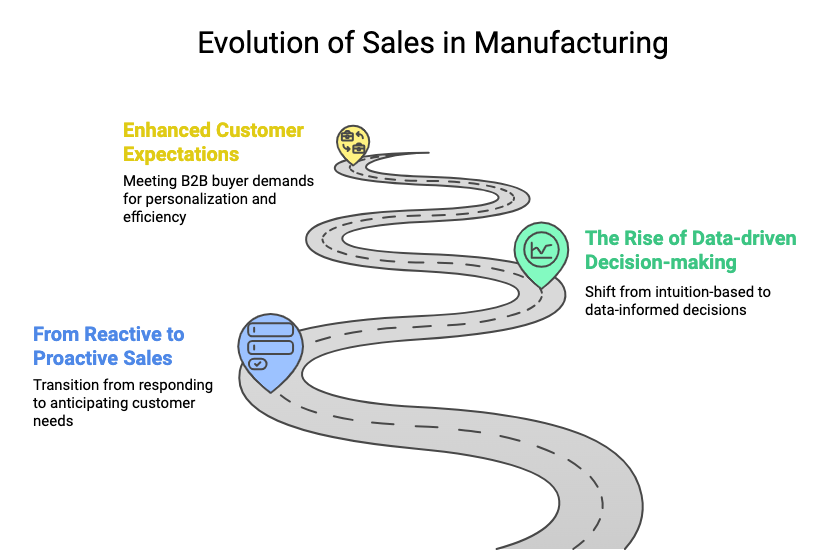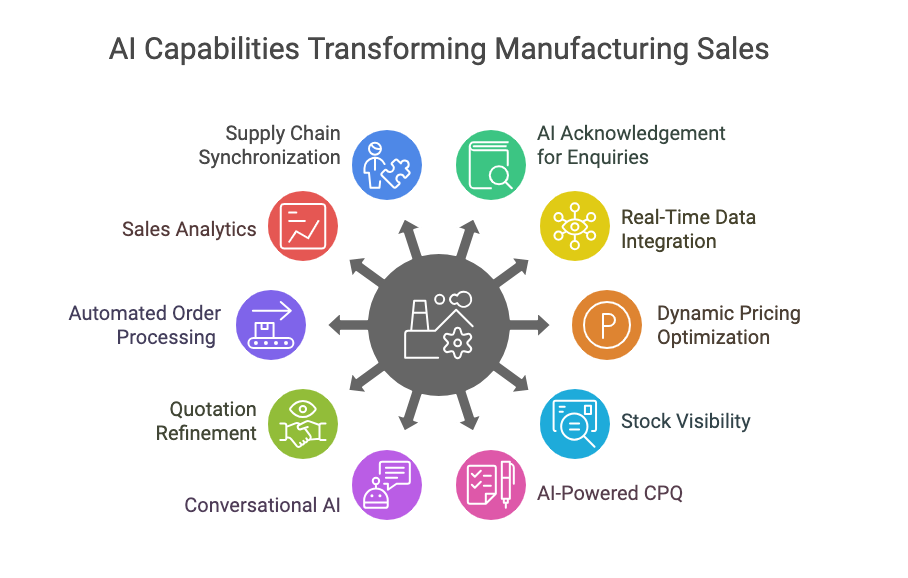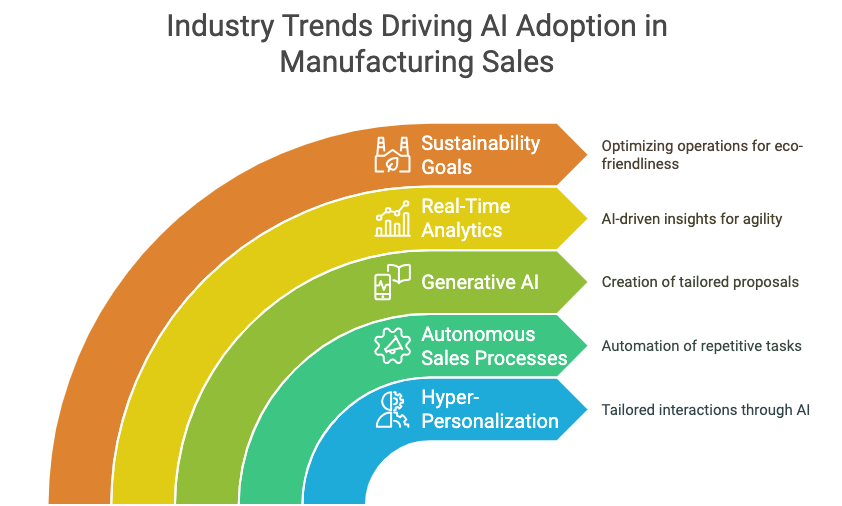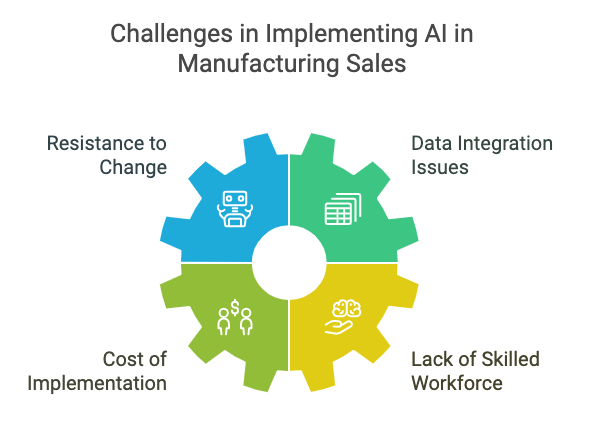The manufacturing industry has long stood as the backbone of global economies, driving innovation and shaping the way we produce and consume goods. Over the decades, this sector has faced waves of transformation from the advent of assembly lines to the integration of automation and robotics. Yet, as we enter a new era of digital disruption in manufacturing, the need for adaptability and innovation has never been greater.
Manufacturers must navigate an intricate web of global supply chains, evolving customer expectations, and intense competition. Traditional approaches to manufacturing sales, once reliable, now struggle to meet the demands of a rapidly changing world. Sales process optimization, agility, and insight are no longer optional; they are essential to maintaining a competitive edge.
Artificial intelligence (AI) is a powerful force that is reshaping the way manufacturers approach sales. Far beyond automation, AI in manufacturing sales empowers businesses to harness vast amounts of data, uncover actionable insights, and make smarter, faster decisions. In this blog, we’ll delve into the top 10 AI capabilities transforming manufacturing sales, highlight emerging AI trends in manufacturing, and examine the challenges and opportunities in adopting AI solutions for industrial sales.
The Evolution of Sales in Manufacturing

1. From Reactive to Proactive Sales
Historically, manufacturing sales were reactive, often driven by responding to incoming inquiries or orders. However, with AI, sales teams can now predict customer needs, enabling proactive engagement that fosters stronger client relationships and improved retention.
2. The Rise of Data-driven Decision-making
Manufacturing sales are increasingly informed by data rather than intuition. AI processes vast amounts of information from customer interactions, market trends, and internal operations, providing actionable insights that enhance decision-making across the sales lifecycle.
3. Enhanced Customer Expectations
Today’s B2B buyers expect a personalized and seamless experience akin to B2C interactions. AI enables manufacturers to meet these expectations by providing tailored solutions, faster responses, and data-backed recommendations that add tangible value to the buying journey.
AI Capabilities Transforming Manufacturing Sales

1. AI Acknowledgement for Enquiries
AI-powered systems instantly respond to sales enquiries by mapping them to historical data, reducing response time and ensuring accuracy. It helps manufacturers quickly address client needs and provide relevant solutions.
Features:
- Historical Data Mapping: Links current enquiries with past interactions for insights.
- Unstructured Data Processing: Extracts information from emails or documents.
- Fast Turnaround: Responds in real time to improve efficiency.
- Customer Profiling: Matches inquiries with customer history for tailored responses.
Example: A construction equipment manufacturer uses AI to acknowledge RFQs by referencing similar past orders, reducing delays in follow-ups.manufacturer uses AI to acknowledge RFQs by referencing similar past orders, reducing delays in follow-ups.
2. Real-Time Data Integration
Seamlessly combining live data with historical records, AI enables accurate quotations and better decision-making during the sales cycle.
Features:
- Live Data Sync: Integrates stock, pricing, and production data.
- Error Reduction: Prevents inaccuracies caused by outdated information.
- Cross-System Integration: Connects ERP, CRM, and other systems.
- Competitive Edge: Ensures quotes adapt to market trends.
Example: A precision components supplier integrates stock data in real-time to ensure order feasibility before committing to deliveries.
3. Dynamic Pricing Optimization
Pricing strategies evolve dynamically through AI, adjusting rates based on market demand, raw material costs, and competitor activity. This ensures competitiveness while protecting profitability.
Features:
- Cost-Based Pricing: Updates pricing based on raw material changes.
- Market Trend Monitoring: Tracks competitor pricing and demand shifts.
- Profit Margin Safeguards: Maintains profitability thresholds.
- Custom Pricing Models: Tailored pricing for specific customers.
Example: A steel manufacturer adjusts prices daily, considering fluctuations in raw material costs and export tariffs.
4. Stock Visibility
Real-time visibility into inventory empowers sales teams to align quotes with stock availability, reducing delays and ensuring customer satisfaction.
Features:
- Real-Time Monitoring: Tracks inventory levels at all times.
- Part Number Decoding: Simplifies stock matching for complex items.
- Stock Alerts: Highlights critical inventory thresholds.
- Demand Forecasting: Predicts inventory needs accurately.
Example: A packaging materials supplier ensures stock levels align with customer orders, avoiding shortages during peak demand.
5. AI-Powered CPQ (Configure, Price, Quote)
Streamlining the CPQ process, AI handles complex machinery configurations and pricing to improve quote accuracy and turnaround times.
Features:
- Configuration Management: Automates custom machinery setups.
- Pricing Intelligence: Accounts for live costs and historical deals.
- Customer-Specific Adjustments: Delivers personalized pricing.
- Automated Workflows: Minimizes manual intervention.
Example: A robotics company accelerates quoting for custom assembly line solutions, tailoring specifications to the client’s needs.
6. Conversational AI
By handling technical enquiries effectively, conversational AI supports sales teams and enhances customer interactions through real-time assistance.
Features:
- Technical Query Handling: Provides accurate responses to complex questions.
- Multilingual Support: Engages customers globally in multiple languages.
- Real-Time Assistance: Offers on-the-spot guidance for sales reps.
- Learning Capabilities: Continuously refines responses based on interactions.
Example: An industrial tools manufacturer deploys AI to assist with detailed inquiries about CNC machine specifications.
7. Quotation Refinement
Leveraging customer data and market insights, AI fine-tunes quotations to ensure they align with client needs and maximize deal potential.
Features:
- Market Trend Analysis: Adapts quotes to dynamic industry conditions.
- Customer-Specific Insights: Personalizes quotes for key accounts.
- Speed Optimization: Expedites quotation processes.
- Data-Driven Adjustments: Incorporates urgency and historical trends.
Example: A chemical supplier revises quotes using AI insights, balancing market conditions with client-specific requirements..
8. Automated Order Processing
Order workflows become more efficient as AI handles everything from BOM checks to final approvals, reducing errors and accelerating order completion.
Features:
- Workflow Automation: Manages routine tasks seamlessly.
- Approval Optimization: Simplifies purchase order validation.
- Error Detection: Identifies discrepancies proactively.
- Order Status Tracking: Updates stakeholders on progress.
Example: An electronics assembly firm speeds up processing by automating validation for large-scale component orders.s.
9. Sales Analytics
Transforming raw sales data into actionable insights, AI links metrics with production and operational KPIs to enhance strategic decisions.
Features:
- Performance Dashboards: Simplifies tracking of key metrics.
- Production-Sales Alignment: Connects sales outcomes to operational goals.
- Predictive Insights: Identifies trends and opportunities.
- Custom Reporting: Provides tailored data analysis.
Example: A packaging manufacturer uses AI analytics to link sales trends with factory output, reducing bottlenecks in production.
10. Supply Chain Synchronization
Aligning sales forecasts with supply chain operations, AI minimizes lead times and ensures on-time delivery, even during market fluctuations.
Features:
- Forecast Integration: Connects sales data with MES and ERP systems.
- Delivery Optimization: Plans shipments efficiently based on demand.
- Demand-Supply Alignment: Balances inventory and production needs.
- Lead Time Reduction: Accelerates fulfillment cycles.
Example: A beverage producer aligns sales forecasts with production schedules to ensure seamless seasonal deliveries.
Industry Trends Driving AI Adoption in Manufacturing Sales

- Hyper-Personalization in B2B Sales
B2B buyers expect tailored interactions, and AI delivers through advanced segmentation and customer insights. This enables manufacturers to craft highly personalized offers and communication strategies, enhancing engagement and conversions.
- Rise of Autonomous Sales Processes
AI-powered sales systems automate repetitive tasks like data entry, lead scoring, and order processing, reducing dependency on human effort. This improves efficiency and allows manufacturing sales teams to focus on strategic decision-making..
- Integration of Generative AI
Generative AI helps create tailored proposals, presentations, and content at scale. This not only accelerates sales cycles but also enhances the quality and relevance of customer-facing materials.
- Real-Time Analytics for Agile Decisions
AI-driven analytics provide real-time insights, empowering sales teams to respond quickly to market shifts. This agility is essential in competitive and dynamic manufacturing sectors.
- Sustainability Goals Driving AI Usage
AI for sustainable manufacturing sales optimizes both sales and operations by reducing waste, energy use, and inefficiencies. As manufacturers align with sustainability goals, AI becomes a key enabler of eco-friendly sales strategies.
Challenges in Implementing AI in Manufacturing Sales

Resistance to Change
Employees may view AI as a threat to job security or fear disruption to established workflows. This resistance can slow adoption and limit the effectiveness of AI implementations.
Solution: Provide training to demonstrate AI’s supportive role and address concerns proactively.
Data Integration Issues
Many manufacturers rely on legacy systems that create data silos, making it difficult for AI to access and process information effectively. This limits AI’s potential impact on operations.
Solution: Use integration platforms to unify data across systems and enable seamless functionality.
Cost of Implementation
The upfront investment required for AI tools and infrastructure can be a significant barrier, especially for smaller manufacturers. Concerns over ROI may further delay decisions.
Solution: Begin with modular AI tools that scale with needs and deliver immediate value.
Lack of Skilled Workforce
AI adoption requires expertise in deployment, management, and optimization, which many teams lack. This skills gap can hinder successful implementation and long-term use.
Solution: Upskill existing employees and partner with AI vendors for expert guidance.
How to Get Started with AI in Manufacturing Sales

- Identify High-Impact Areas
Analyze your sales processes to find tasks like lead scoring, forecasting, or order management that can benefit most from AI. Focus on areas with clear ROI to justify the initial investment.
- Leverage Existing Data
Audit your current data sources, including CRM and ERP systems, to ensure data quality and availability. AI thrives on accurate, structured data, making data preparation a critical first step.
- Start Small with Pilot Projects
Implement AI in a single process, such as predictive sales forecasting or dynamic pricing. Monitor its performance and refine your approach before scaling it across the organization.
- Invest in Scalable Solutions
Choose modular AI platforms that allow you to add features as your needs evolve. Scalable solutions ensure that your investment grows with your operations and minimizes disruption.
- Train Teams and Foster Collaboration
Empower your sales and operations teams with AI knowledge through training programs. Highlight how AI complements their roles, ensuring a smooth adoption and maximizing its effectiveness.
The Future of AI in Manufacturing Sales
The future of AI in manufacturing sales promises unprecedented efficiency and customer-centricity. As AI continues to evolve, AI’s role in sales automation is becoming increasingly vital for businesses looking to stay ahead in a competitive market. With the integration of generative AI, manufacturers will be able to craft hyper-personalized proposals and marketing strategies at scale, as seen in cross-industry AI applications like oil and gas, elevating the B2B sales experience. where similar innovation is reshaping industrial operations. Real-time analytics will continue to drive agile decision-making, enabling businesses to adapt to market changes with unmatched precision.
As sustainability in manufacturing takes center stage, AI will play a pivotal role in aligning sales operations with eco-friendly goals. Manufacturers will optimize inventory, logistics, and supply chain functions while minimizing waste, catering to environmentally conscious buyers. The rise of autonomous sales processes in manufacturing further signals a future where repetitive sales tasks are automated, allowing teams to focus on building strategic relationships.
Conclusion
AI is no longer a futuristic concept; it is a transformative force reshaping manufacturing sales. By enhancing sales efficiency in manufacturing, enabling hyper-personalization, and fostering sustainable practices, AI for manufacturers equips businesses to stay competitive in a dynamic industrial market. However, successful implementation requires thoughtful planning from identifying high-impact AI use cases in sales to ensuring team alignment and scalable AI solutions.
While challenges like resistance to AI adoption or integration with legacy systems exist, they can be overcome with strategic investments in AI and cross-functional collaboration. Manufacturers embracing AI in sales today are not just improving their current operations but also future-proofing manufacturing businesses. The key lies in taking proactive steps to harness AI’s potential, ensuring a seamless AI integration that benefits both teams and customers alike. In a rapidly evolving industry, AI in manufacturing sales stands as a catalyst for growth, innovation, and sustained success.
